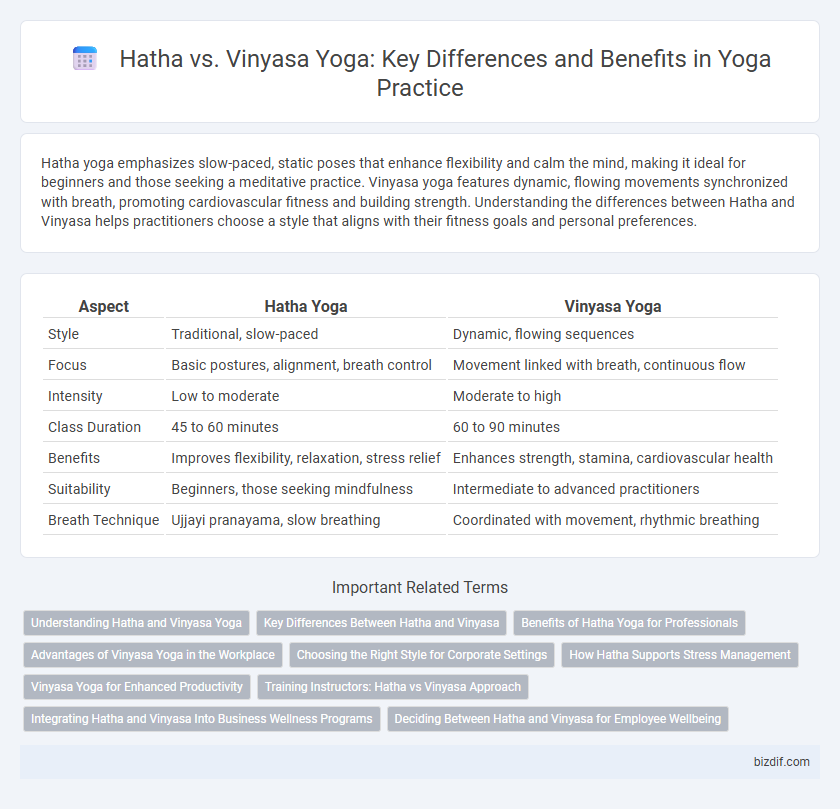Hatha yoga emphasizes slow-paced, static poses that enhance flexibility and calm the mind, making it ideal for beginners and those seeking a meditative practice. Vinyasa yoga features dynamic, flowing movements synchronized with breath, promoting cardiovascular fitness and building strength. Understanding the differences between Hatha and Vinyasa helps practitioners choose a style that aligns with their fitness goals and personal preferences.
Table of Comparison
| Aspect | Hatha Yoga | Vinyasa Yoga |
|---|---|---|
| Style | Traditional, slow-paced | Dynamic, flowing sequences |
| Focus | Basic postures, alignment, breath control | Movement linked with breath, continuous flow |
| Intensity | Low to moderate | Moderate to high |
| Class Duration | 45 to 60 minutes | 60 to 90 minutes |
| Benefits | Improves flexibility, relaxation, stress relief | Enhances strength, stamina, cardiovascular health |
| Suitability | Beginners, those seeking mindfulness | Intermediate to advanced practitioners |
| Breath Technique | Ujjayi pranayama, slow breathing | Coordinated with movement, rhythmic breathing |
Understanding Hatha and Vinyasa Yoga
Hatha Yoga emphasizes slow, deliberate postures and controlled breathing to enhance flexibility and balance, making it ideal for beginners seeking foundational strength. Vinyasa Yoga links breath with dynamic movement, creating fluid sequences that build endurance and cardiovascular health. Both practices offer unique benefits by combining physical postures (asanas) and breath control (pranayama) but differ in pace and intensity levels.
Key Differences Between Hatha and Vinyasa
Hatha yoga emphasizes slow-paced, static postures and deep breathing techniques, ideal for beginners seeking alignment and mindfulness. Vinyasa yoga features dynamic, flowing sequences that synchronize breath with movement, promoting cardiovascular endurance and flexibility. The key difference lies in Hatha's deliberate pace versus Vinyasa's continuous, rhythmic transitions.
Benefits of Hatha Yoga for Professionals
Hatha Yoga offers professionals a restorative practice that enhances mental clarity and reduces stress through gentle, deliberate poses and mindful breathing techniques. This style improves posture and physical alignment, counteracting the effects of prolonged sitting and enhancing overall body awareness. Regular Hatha sessions promote sustained focus and balanced energy, contributing to increased productivity and well-being in demanding work environments.
Advantages of Vinyasa Yoga in the Workplace
Vinyasa Yoga enhances workplace wellness by promoting cardiovascular health through dynamic, flowing sequences that increase heart rate and improve circulation. This style improves mental clarity and reduces stress by synchronizing breath with movement, helping employees maintain focus and productivity. Incorporating Vinyasa sessions in office environments supports flexibility, strength, and collaborative energy, fostering a balanced and energized workforce.
Choosing the Right Style for Corporate Settings
Hatha yoga offers a slower pace and emphasis on alignment, making it ideal for stress reduction and mindfulness during corporate breaks. Vinyasa yoga incorporates dynamic sequences and breath-synchronized movements, which enhance energy flow and cardiovascular health, appealing to teams seeking an active and engaging practice. Selecting the right style depends on workplace goals--Hatha supports relaxation and focus, while Vinyasa boosts stamina and team vitality.
How Hatha Supports Stress Management
Hatha yoga emphasizes slow, deliberate movements and deep breathing techniques that promote relaxation and reduce cortisol levels, effectively supporting stress management. This style encourages mindfulness and body awareness, which help calm the nervous system and enhance mental clarity. Compared to the more dynamic flow of Vinyasa, Hatha's gentle pace makes it accessible for beginners seeking to alleviate anxiety and improve overall well-being.
Vinyasa Yoga for Enhanced Productivity
Vinyasa yoga emphasizes dynamic, flowing movements synchronized with breath, promoting increased blood circulation and mental clarity that boost productivity. Unlike Hatha yoga's slower, static poses, Vinyasa's continuous sequences stimulate energy and focus, enhancing cognitive function and stress resilience. Incorporating Vinyasa into daily routines can lead to improved concentration and sustained motivation throughout demanding workdays.
Training Instructors: Hatha vs Vinyasa Approach
Training instructors in Hatha yoga emphasize alignment, breath control, and holding poses to cultivate stamina and mindfulness, supporting students in foundational practice. Vinyasa instructor training focuses on fluid transitions, synchronization of movement with breath, and dynamic sequences to build strength and cardiovascular endurance. Understanding these distinct approaches aids instructors in tailoring techniques to student needs, enhancing teaching effectiveness across varied yoga styles.
Integrating Hatha and Vinyasa Into Business Wellness Programs
Integrating Hatha and Vinyasa yoga into business wellness programs enhances employee well-being by combining Hatha's focus on alignment and breath control with Vinyasa's dynamic, flow-based sequences that promote cardiovascular health and stress relief. Offering both styles allows for tailored sessions that accommodate varying fitness levels and personal preferences, maximizing participation and engagement. Employers benefit from improved workplace morale and reduced stress-related absenteeism through this balanced approach to yoga instruction.
Deciding Between Hatha and Vinyasa for Employee Wellbeing
Choosing between Hatha and Vinyasa yoga for employee wellbeing depends on goals and energy levels; Hatha offers slower, gentle postures that enhance relaxation and focus, suitable for stress reduction and beginners. Vinyasa involves dynamic, flow-based sequences that combine breath with movement, promoting cardiovascular health and increased energy, fitting for active employees seeking a more vigorous practice. Evaluating workplace wellness needs and individual preferences ensures the best alignment with overall health and productivity objectives.
Hatha vs Vinyasa Infographic

 bizdif.com
bizdif.com